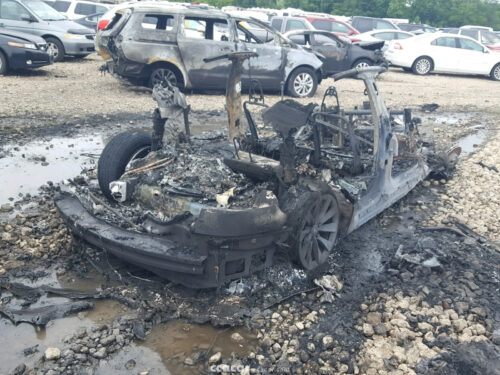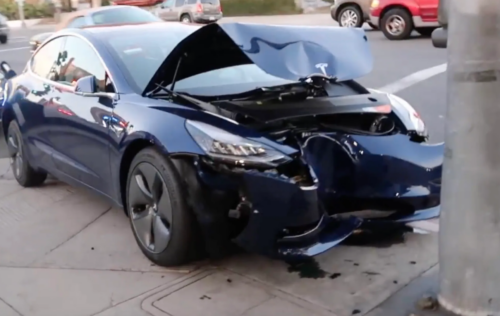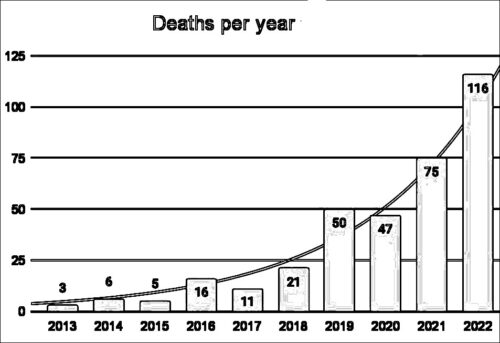
Yes, of course.
The fire department said yet another Tesla just burst into flames without warning, I mean a warning other than the badge on the hood.
It’s all over the news and for good reason, even while the Vancouver fire is barely being reported.
Within two or three minutes, he said, the whole car was on fire. “The whole thing just burst into flames.”
Tesla is a fraud, a rolling death trap. It’s nice people ask me about it, but something else has been on my mind lately.
I ask them all in return if they know how many Tesla go from the dealer to the junk yard with almost no miles.
Nobody has said yes.
I’ve written about it before here, and some of my security talks since 2016 have been based on this state of disaster, not to mention others’ research.
Using a salvaged Tesla Model 3 purchased at auction last year, researchers discovered all of the mobile devices that had been paired to the car, as well as phone numbers and email addresses from those devices. It discovered that it was owned by a construction company in the Boston area, the last six dozen addresses entered into the navigation and video footage from the crash that sent it to the junkyard. That was from one of the many cameras in Teslas that owners have often said they don’t know when they’re actually on. And, according to the business news network, it’s somewhat difficult for even owners to clear that data off of their Tesla.
My first (and last) ludicrous ride was using a Tesla pulled from a junk yard to be reverse engineered; its “driverless” system was exposed and audited (to predict reliably whether Tesla would kill many people, which it has done). It’s probably this hands-on junkyard experience a decade ago that had the most impact on my view of the vehicle as dangerous to society.
Nonetheless, since people are still surprised today, I’ll say it again.
No, even better, I’ll let someone else explain:
Of more than 120 Model Ys that were totaled after collisions, then listed at auction in December and early January, the vast majority had fewer than 10,000 miles on the odometer, according to online data from Copart and IAA, the two largest salvage auction houses in the United States. The retail prices of those cars ranged from about $60,000 to more than $80,000.
How many $60,000 or higher vehicle brands so regularly fail to get more than 10,000 miles on their odometer?
Don’t forget this car company boasted to investors shortly after launch it would be the safest of all.
Here’s even more detail from the same article.
An Austin-built 2022 Model Y Long Range involved in a front collision and listed by IAA in early January had a retail price of $61,388 and estimated repair cost of $50,388. The vehicle’s owner was not listed. A second Austin-built Model Y, involved in a side collision and listed by IAA, had a retail price of $72,667 and estimated repair cost of $43,814.
What a bunch of regressive environmentally toxic junk.
I remember the Audi A8 warning about its special construction (“space frame” introduced 1994), which meant a nightmare to repair unless the owner had access to certified aluminum welders — almost certain rapid depreciation. Tesla took an exact opposite marketing approach by falsely promoting its extremely high cost difficult to repair vehicle as a long term investment and the huge losses have been… sadly predictable.
There are many simple explanations for why Tesla is again proven to be a total fraud. Here are three:
First, and most notable, is a CEO preying on fear to inflate his ego (ponzi scheme). As soon as he heard about people fearing a crash (related to a Tesla owner suing the company), he started repeatedly claiming his cars will soon magically avoid a crash (they can’t).
According to Musk, Tesla actually “hustled so much” to get the “V1” iteration of Autopilot released to consumers. This was because a driver had fallen asleep behind the wheel of a non-Autopilot Tesla and crashed into a cyclist. … Musk stated that the driver who struck the cyclist actually sued Tesla after the tragedy, claiming that his vehicle’s “new car smell” caused him to fall asleep.
Musk used this tragedy to start promoting his car as safe for drivers to fall asleep in. He spun common fears into disinformation about faith; engaged in really, really targeted social engineering attacks to spear people using false comfort, not just the usual bland exaggeration about product.
When people said drivers who fall asleep kill, Tesla’s CEO jumped on it to suggest everyone should go ahead and prepare to fall asleep in his cars… which then actually killed them and/or others.
Tesla drivers will be able to fall asleep behind the wheel by 2021, says Elon Musk
Tesla safety has been this kind of an absurd lie since 2013, absolutely proven false since at least 2016, yet many still buy the car because they aren’t qualified to judge such baseless and illegal claims.
Belief in the lies gives them false comfort, extremely dangerous for operating a vehicle. People in fact crash as soon as they start driving these catch-me-if-you-can lying clown cars. The data shows Tesla makes drivers worse, less safe than if they drove another car.
Oh, but isn’t there a boiler plate warning that tells people the opposite of what the CEO says?
Risk research suggests the boiler plate warning when coupled with the exaggerated lies of the CEO are far worse than if there was no warning at all. It’s perhaps counter intuitive, but studies show either the CEO has to stop lying or the warnings have to be removed; the combination of the two is the most dangerous because people are primed to ignore warnings.
In Nigeria the advance fee fraud criminals say they don’t feel sorry for their victims. The line generally goes that if the victim hadn’t believed in a better life, hadn’t taken the bait of safety promises, then they wouldn’t have lost everything… so the liars say it’s their victim’s fault for believing in a liar.
That’s the Tesla fraud.
Second, the car is designed and engineered so poorly it crashes often. There is copious evidence of workplace fraud and shortcuts that weaken safety, even worker abuse in factories… lists of basic manufacturing failures that are endless.
A culture of abuse and pollution.
I’ve called the results of this Tesla in Pole Position — meaning they are being credited with 10 out of 10 deaths — because their “best” engineering keeps abruptly slamming directly into poles.

Nissan (early mover advantage in EV) and Mercedes (early mover advantage in driverless) both far exceed the late-comer (1997 TZero knock-off) Tesla in quality and safety. Economy or luxury, Tesla is the worst.
Did you know Nissan runs nearly the same number of cars as Tesla on the road using “driverless” software, yet Nissan had ZERO crashes to report to regulators?
That’s quality.
Tesla’s software by comparison has had so many bugs and fatalities from crashes we’re having to start a count of graveyards.

It stands alone as an EV lacking hardware innovation (2012 model S is the same today, nobody wants one, and its look-alike derivatives have only gotten worse with time).
Third, high repair cost is not rocket science. Tesla is literally saying in 2023 that they are realizing bumpers could be designed for better parts availability and lower cost for minor repairs.
I refer you again to the Audi A8 that was honest about its engineering, warning people to not buy the car if they planned to inexpensively repair things.
Ten years ago people would grab a wrecked Tesla, hack them back together and put them out as rogue vehicles (disconnected from Tesla). Then people realized just how much Tesla sucks overall, and they moved the Tesla’s TZero guts to project cars. Now, there’s not really a point to either. It’s a disposable landfill nightmare.
Tesla is just a terrible company that struggles to deliver more than 10,000 miles without a catastrophic event. Hundreds of vehicles showing up like this is NOT explained by a bad driver or a patch of road.
Although, to be fair, Tesla’s brand does attract people who don’t want to drive and are likely bad drivers. That goes back to my first point, though.
It’s hard to say with certainty what was going on inside the vehicle, but it appears that the Model Y actually accelerates into the opposing lane, suggesting that the driver may have mistakenly hit the accelerator pedal instead of the brake. That sends the Model Y into the path of a silver Model S and gives the sedan driver almost no time to react and nowhere to go, leading inevitably to a collision.
Tesla leading inevitably to a collision? That sounds accurate, if you move up the timing to within the first six months.
Bottom line, while spontaneous fire is a regular Tesla fact, the even bigger picture is that the whole company is a raging dumpster fire.
We’re not talking enough about the systemic flaws in risk management within this third rate mediocre car company. It simply doesn’t make a product safe or reliable enough for mass market. Worse, it knows its safety warnings aren’t working and undermined by its own marketing.
The latest rankings of the top seven electric SUV put Tesla dead last (scoring in the 70s while all others are in the 80s). It shouldn’t even be on this list given deadly “flaws in comfort and build quality”.
1. BMW iX
2. Genesis GV60
3. Cadillac Lyriq
4. Volvo XC40 Recharge
5. Mercedes-Benz EQB
6. Audi e-tron
7. Tesla Y
“Y” indeed. Why would anyone buy a Tesla? It is the sad lawn dart of the car industry.
It should be banned and the CEO in jail.
A very useful and honest report. Tesla probably getting a kickback from junkyards. Cars in general are death traps. Gasoline vehicles out rank EVs in vehicle fires but only because of electrical fires. EVs are3 an emerging technology making things worse without regulation. I imagine Tesla to be an irresponsible company ignoring decades of electrical fire data to avoid improving the outcome of existing and future products. They could ask any poor ill-informed schmuck and do better, but instead the CEO wants to ruin the company as if he were David. Tesla is forever off my bucket list.
If the exploding battery don’t get them then the WHOMPY WHEELS will.
https://www.flickr.com/photos/136377865@N05/albums/72157658490111523
Wise sounds right. Taxation system within a cult. People stuck in thinking it’s going to be something it never will be, following advice to total their vehicle because that’s good for Tesla stock.
Low mileage scrapped teslas are in that state not just because of the low quality of the car, but Tesla heavily coerces owners to scrap cars based on a salvage title. You may not be forced, but they will disable fast charging, hence the rationale to just get a new Tesla thru insurance and get the full functionality of the car. Absolutely that makes me raise my eyebrows, as I have managed to survive in a beat up damaged car for years and it’s the only thing my budget would allow! If I got into a fender bender and then Tesla disables my fast charging, I basically am being forced by them to renew constantly or lose what I paid for. Imagine a diamond mine that not only artificially created scarcity and status but devalued your “forever” purchase within the first year. It’s a hidden subscription system and that’s why Tesla doesn’t care about crashes going down. Who would they sell cars to? New customers? With the other EV brands beating them in every way, their cult worship is strong maybe worse than blood diamonds.
New Tesla owner makes unsafe lane change and wrecks his car within first three hours says he’s going to use insurance to buy another one right away. It’s almost like every other driver is supposed to fund these over priced throwaway cars.
A big slow trailer does a better job evading oncoming traffic than this brand new Tesla.
https://youtu.be/U851xxKXBPg
Its funny i’ve seen pictures of dozens of burning Teslas each year on FB i met a fireman from a small town, his shift had been to 3 catastrophic tesla fires in the last month but zero ice fires! I believe the data is supressed!
No mention of how Tesla made disposable cars mainstream and acceptable? Every EV copied Tesla’s battery pack design. The problem has grown bigger than just Tesla, every single EV for sale today is disposable. Nobody wants an EV out of warranty, the battery costs more than the actually car at that point. Your article covers all these points, but it doesn’t link them together and announce that all EVs are disposable vehicles, as long as they maintain using non-serviceable battery packs. If 2035 ends ICE sales this style of EVs will ultimately end the used car market. It’ll be new only with auto makers buying any used cars and replacing n’ upgrading the battery packs so they can be sold at almost original msrp. Kind of like what Tesla does now, but they won’t let owners upgrade their existing battery pack. The HEPA filter commercials I’ve seen on YouTube lately is comical, due to the fact chemical exposure would void the warranty.
This story is very valuable. Tesla fires have killed 83 people in 3 million cars (https://www.tesla-fire.com/) versus Pinto fires killed 25 people in 3 million cars.
I will never buy anything GAS and OIL again, CHARGE BABY CHARGE.